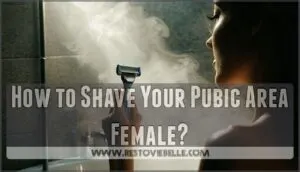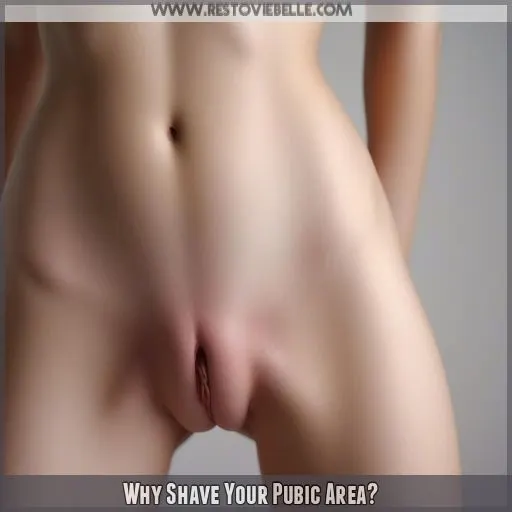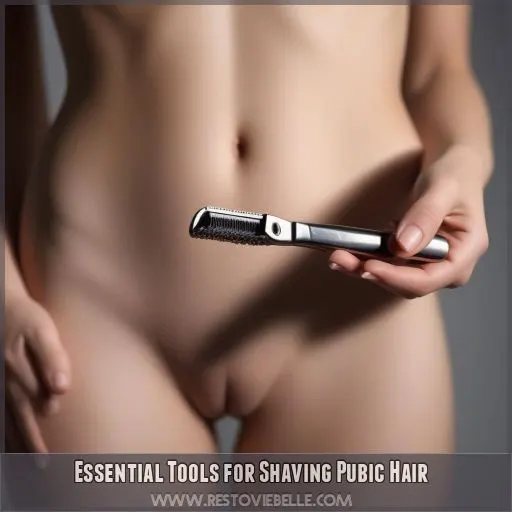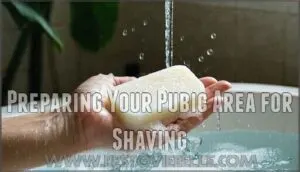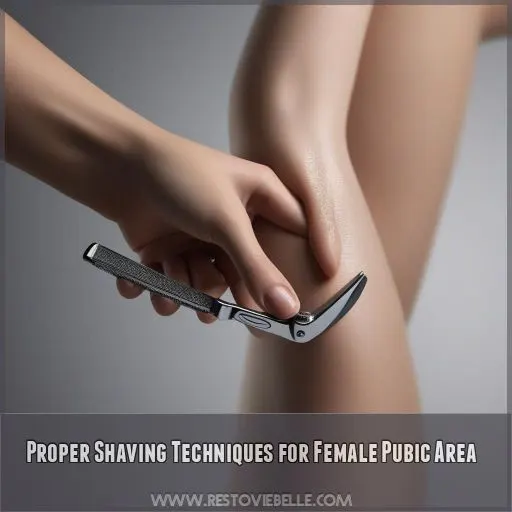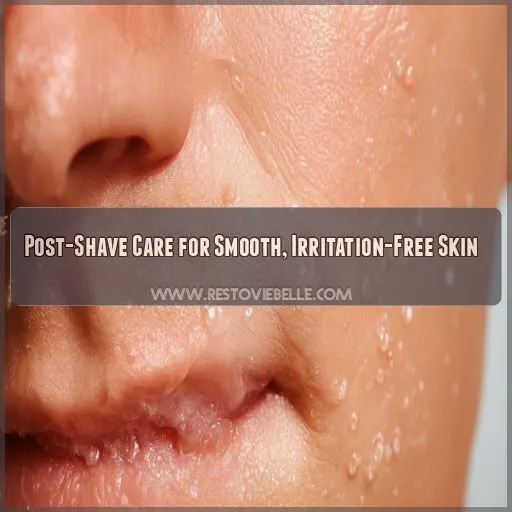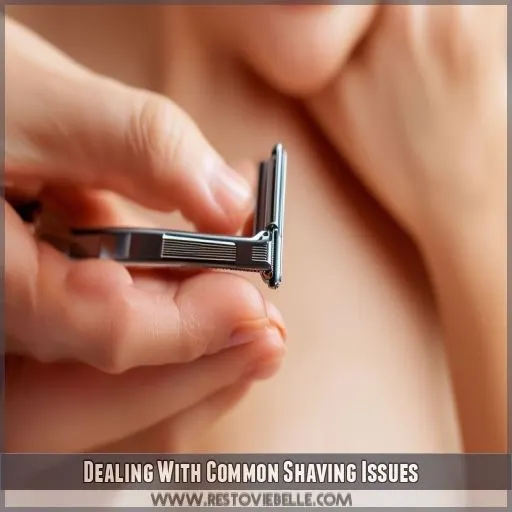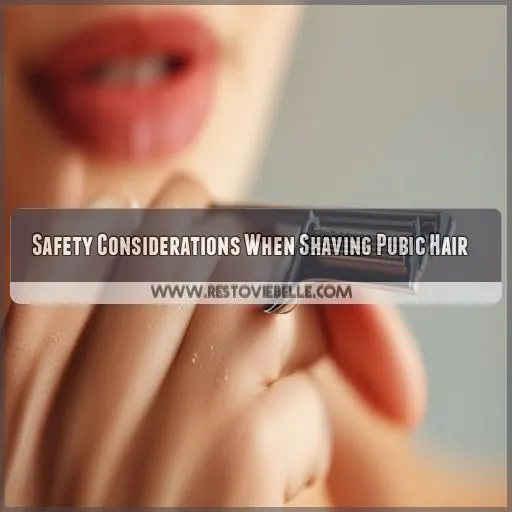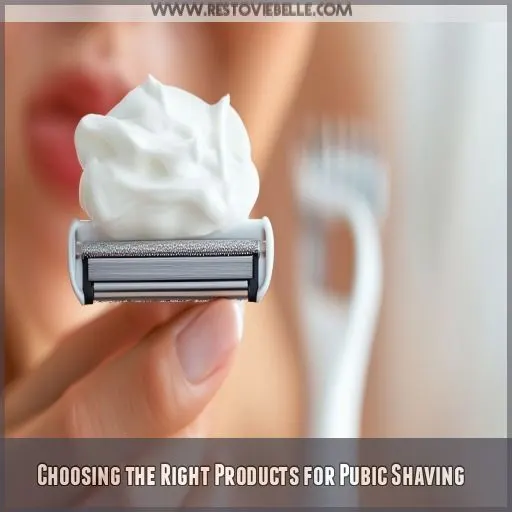This site is supported by our readers. We may earn a commission, at no cost to you, if you purchase through links.
 Shaving your pubic area can be a bit tricky.
Shaving your pubic area can be a bit tricky.
But with the right tools and techniques, you can get smooth results without the hassle.
Whether it’s for hygiene, comfort, or personal preference, knowing how to shave this sensitive area properly is key.
Grab your razor and get ready to take on the challenge with these essential tips and tricks specifically for women.
Let’s get started!
Table Of Contents
- Key Takeaways
- How to Shave Your Pubic Area Female?
- Why Shave Your Pubic Area?
- Essential Tools for Shaving Pubic Hair
- Preparing Your Pubic Area for Shaving
- Proper Shaving Techniques for Female Pubic Area
- Post-Shave Care for Smooth, Irritation-Free Skin
- Dealing With Common Shaving Issues
- Maintaining a Smooth Pubic Area
- Alternative Hair Removal Methods for Pubic Area
- Safety Considerations When Shaving Pubic Hair
- Choosing the Right Products for Pubic Shaving
- Frequently Asked Questions (FAQs)
- What is the proper way to shave your private area female?
- How to remove hair from private parts for a woman?
- How often should a woman shave her private part?
- Should I shave pubic hair wet or dry?
- Is it better to use a razor or hair removal cream?
- How often should I change my razor?
- What should I do if I get razor burn?
- How long should I wait to exercise after shaving?
- Can I use the same razor for my legs and pubic area?
- Conclusion
Key Takeaways
- Shaving your pubic area can be a tricky task, but with the right tools and techniques, you can achieve smooth results and boost your personal hygiene, comfort, and confidence.
- Proper preparation is key: trim longer hair, cleanse the area, exfoliate to prevent ingrown hairs, and apply pre-shave oil or lotion for a smooth canvas.
- Choose the right shaving direction and use gentle, short strokes with a clean, sharp razor. Rinse frequently and reapply shaving cream as needed to prevent skin irritation.
- Post-shave care is essential: rinse with cool water, pat the area dry gently, and apply a soothing moisturizer. Maintain your smooth pubic area by exfoliating regularly, moisturizing daily, and wearing breathable underwear.
How to Shave Your Pubic Area Female?
It’s totally up to you if you want to shave your pubic hair. There are a few benefits, like better hygiene and less sweat. If you decide to go for it, make sure you use a new, clean razor to prevent bacteria and skin irritation.
You’ll want to trim longer hairs first, and then shave in the direction of hair growth. This will give you a smooth shave and help you avoid razor burn.
Keep going for more tips on shaving your pubic area, including how to get the best results and deal with any problems.
Why Shave Your Pubic Area?
Wondering why you should shave your pubic area? From boosting hygiene to enhancing personal comfort, there are several compelling reasons to think about this grooming practice. Whether you’re looking to feel fresh, confident, or simply curious about trying something new, understanding the benefits can help you make an informed decision about your intimate care routine.
Hygiene and Cleanliness
Keeping your pubic area smooth isn’t just about looks. It’s a hygiene game-changer! By shaving, you’re:
- Banishing that not-so-fresh feeling
- Waving goodbye to trapped sweat and bacteria
- Simplifying your intimate care routine
- Boosting your overall cleanliness confidence
Embrace the clean slate!
Personal Comfort and Confidence
Beyond hygiene, shaving can boost your confidence and self-love. Feeling smooth down there might make you strut your stuff with a little extra pep in your step. It’s all about what makes you feel comfortable in your own skin.
Aesthetic Preferences
You might choose to shave for aesthetic reasons. Many women prefer:
- A smoother look and feel
- Enhanced sensation during intimate moments
- Easier hygiene maintenance
- Confidence in swimwear or lingerie
It’s all about what makes you feel comfortable in your own skin.
Cultural and Social Influences
You might feel pressure to shave due to cultural beauty standards or social norms. From bikini-ready bodies to smooth skin trends, society often pushes hair removal. Remember, it’s your choice – embrace your natural look or go bare, whatever makes you feel confident!
Medical Reasons
While cultural norms play a role, medical reasons might also prompt pubic hair removal. Here are some situations where your doctor might recommend trimming or shaving:
- Preparing for surgery
- Managing skin conditions
- Treating pubic lice
- Easing hygiene during menstruation
- Facilitating medical examinations
Essential Tools for Shaving Pubic Hair
Now that you’re ready to take the plunge, let’s talk tools!
Your trusty razor is the star of the show, but don’t forget its supporting cast.
A sharp, clean razor is your best friend for a smooth shave. Pair it with a nourishing shaving cream to keep things slick and comfortable.
For a pre-shave trim, an electric razor can be a game-changer.
Don’t forget exfoliating gloves to buff away dead skin and prevent pesky ingrown hairs.
With these essentials in your arsenal, you’ll be well-equipped for a silky-smooth shaving experience.
Preparing Your Pubic Area for Shaving
Proper preparation is key to achieving a smooth, irritation-free shave in your pubic area. Let’s explore the essential steps you’ll need to take before grabbing that razor, ensuring you’re set up for success and silky-soft skin.
Trimming Longer Hair
Before diving in with your razor, it’s time for a little landscaping! Trimming longer pubic hair is like giving your garden a quick mow before the detailed work. Grab some scissors or an electric trimmer and snip those strands down to about a quarter-inch. Trust us, your razor will thank you later!
Cleansing the Area Thoroughly
Now that you’ve trimmed, it’s time to get squeaky clean! Hop in the shower and let the warm water work its magic. Gently cleanse your pubic area with a mild, fragrance-free soap. This step’s really important for removing any dirt or oils that could interfere with your shave. Think of it as prepping your canvas!
Exfoliating to Prevent Ingrown Hairs
Ready to banish those pesky ingrown hairs? Exfoliating’s your secret weapon! Gently buff away dead skin cells with a soft scrub or loofah, using circular motions. This unclogs pores and frees trapped hairs, paving the way for a smoother shave. Remember, a little TLC goes a long way in preventing razor bumps!
Applying Pre-Shave Oil or Lotion
After exfoliating, it’s time to pamper your skin with pre-shave oil or lotion. This step is like giving your skin a cozy blanket before the big show. Choose a product that suits your needs:
- Moisturizing oils (jojoba, coconut)
- Soothing lotions (aloe vera-based)
- Fragrance-free options
- Natural, organic formulas
Proper Shaving Techniques for Female Pubic Area
You’ve prepped your skin, and now it’s time for the main event: shaving your pubic area. With the right techniques, you’ll achieve a smooth, irritation-free result that’ll make you feel confident and comfortable in your own skin.
Choosing the Right Shaving Direction
| Direction | Pros | Cons |
|---|---|---|
| With | Safer, less irritation | Not as close |
| Against | Closer shave | Higher risk of nicks |
Choose wisely, ladies!
Using Gentle, Short Strokes
Glide your razor with feather-light pressure, using short, gentle strokes. Imagine you’re painting delicate brush strokes on a canvas. This technique helps prevent nicks and irritation, ensuring your pubic area stays smooth and comfortable. Remember, slow and steady wins the race!
Rinsing the Razor Frequently
Don’t let your razor turn into a hair hoarder! Rinse it frequently to keep your shave smooth and hygienic. This simple step can make a world of difference in your pubic hair care routine. Here’s why it’s so important:
- Prevents blade clogging
- Helps you get a closer shave
- Reduces skin irritation
- Maintains razor sharpness
- Improves overall cleanliness
Reapplying Shaving Cream as Needed
Don’t skimp on the shaving cream! Reapply often to keep your skin slick and protected. It’s your secret weapon for a smooth glide and irritation-free results. Think of it as a cozy blanket for your delicate bits – comforting and essential!
Addressing Hard-to-Reach Areas
For those tricky spots, try different angles and use a handheld mirror. Squat or prop your leg up to access hard-to-reach areas. Remember, slow and steady wins the race! Don’t rush – take your time to make sure you get a smooth, nick-free shave.
Post-Shave Care for Smooth, Irritation-Free Skin
You’ve successfully shaved your pubic area, but your job isn’t done yet! Proper post-shave care is important for maintaining smooth, irritation-free skin and preventing common issues like razor burn and ingrown hairs.
Rinsing With Cool Water
After your shave, it’s time for some cool relief! Rinse the area with cool water to soothe your skin and close those pores. It’s like giving your lady bits a mini spa treatment! This step helps calm any inflammation and sets the stage for silky-smooth results. Trust us, your skin will thank you!
Patting the Area Dry
After rinsing, it’s time to dry your newly-smooth skin. But hold your horses! Don’t rub like you’re polishing a trophy. Instead, gently pat the area dry with a soft, clean towel. This tender touch helps prevent irritation and keeps your sensitive skin happy. Remember:
- Use a fresh, fluffy towel
- Pat, don’t rub
- Focus on absorbing moisture
- Be extra gentle around your vagina
Applying Soothing Moisturizer or Aloe Vera
After patting dry, it’s time to pamper your newly smooth skin. Grab your favorite moisturizer or aloe vera gel – nature’s soothing superhero. Gently apply it to the shaved area, giving your skin the TLC it craves. This step’s like a cool drink for thirsty skin, calming any irritation and leaving you feeling silky-soft.
Using Talc-Free Powder to Reduce Friction
After your silky-smooth shave, sprinkle a little magic dust down there! Talc-free powder is your secret weapon against friction’s fiery wrath. It’s like giving your lady bits a comfy cloud to rest on. Cornstarch or arrowroot powder work wonders, keeping you fresh and chafe-free all day long.
Dealing With Common Shaving Issues
Even with careful preparation, you might encounter some bumps along the road to a smooth pubic area. Let’s tackle common shaving issues like razor burn, ingrown hairs, and irritation, so you can keep your skin happy and silky-smooth.
Preventing and Treating Razor Burn
Razor burn got you feeling the heat? Don’t fret! Cool things down with a cold compress, then pamper your skin with soothing aloe vera. For long-term relief, invest in a quality aftershave balm. Remember, prevention is key: Always use a sharp razor and shave with the grain. Your skin will thank you!
Managing Ingrown Hairs
- Exfoliate regularly
- Use a sharp, clean razor
- Moisturize after shaving
- Try hair removal creams
Your pubic area will thank you!
Addressing Cuts and Nicks
Nicks happen, but don’t panic. Clean the area with mild soap and water, then apply pressure with a clean cloth. For stubborn bleeding, try a styptic pencil or alum block. Once it’s stopped, dab on some antibiotic ointment. Remember, a sharp razor is your best friend for a nick-free shave!
Soothing Itchy, Irritated Skin
After addressing cuts, let’s tackle that pesky itch! Your skin’s throwing a tantrum, but don’t worry. Here’s your itchy skin survival kit:
- Cool compress
- Aloe vera gel
- Fragrance-free moisturizer
- Over-the-counter hydrocortisone cream
These soothing heroes will calm the redness and irritation, giving you sweet relief. Remember, your pubic hair’s just trying to protect you!
Maintaining a Smooth Pubic Area
You’ve mastered the art of shaving your pubic area, but maintaining that smooth feeling is the real challenge. Let’s explore some insider tips to keep your bikini line silky and irritation-free between shaves, so you can rock that confidence 24/7.
Frequency of Shaving
Now, let’s talk about how often you should shave your pubic area to maintain that smooth, silky feel.
It really depends on how fast your hair grows and your personal preference for hair length. Some people like to shave every few days to keep stubble at bay, while others wait a week or two until there’s more growth to grab onto with the razor.
Regular Exfoliation Between Shaves
Exfoliation is key to maintaining a smooth pubic area. It helps remove dead skin cells and prevents ingrown hairs. Aim to exfoliate a few times a week, using a gentle exfoliating scrub or mitt. Be sure to choose a product designed for sensitive skin, and always avoid harsh exfoliants that can irritate the area.
Moisturizing Daily
Moisturizing is key to keeping your pubic area soft and smooth. It’s an essential step in your shaving routine, offering a trio of benefits for your skin:
- Hydration: Moisturizers lock in moisture, keeping your skin supple and reducing dryness.
- Soothing: They calm any irritation caused by shaving, helping your skin recover.
- Protection: Moisturizers create a barrier, shielding your skin from potential irritants.
Wearing Breathable, Loose-Fitting Underwear
To keep your pubic area smooth and irritation-free, it’s important to choose the right underwear. Opt for breathable fabrics like cotton or bamboo, which allow air circulation and help keep the area dry. Loose-fitting underwear is also key, as it prevents friction and gives your skin room to breathe.
Alternative Hair Removal Methods for Pubic Area
If you’re looking for alternatives to shaving your pubic area, there are a few other methods you can try. From waxing and hair removal creams to laser hair removal and electrolysis, each method has its own pros and cons.
Waxing: Pros and Cons
Waxing is a popular alternative to shaving your pubic hair. It offers smooth results and can leave you hair-free for weeks. However, it can be costly and time-consuming, requiring regular salon visits. Plus, let’s be real – it hurts! While it’s a quick fix, the pain and cost might be a deal-breaker for some.
Depilatory Creams: Usage and Precautions
Depilatory creams are another option for hair removal. These creams dissolve hair without the use of a blade, reducing irritation risks. But, as with any new product, always do a patch test first, especially if you have sensitive skin.
Laser Hair Removal: Long-Term Results
Laser hair removal is a permanent solution for pubic hair removal. While it’s pricier than other methods, it’s effective for long-term results. You’ll need to consult a dermatologist for this procedure.
Electrolysis: Permanent Hair Removal Option
Electrolysis is a permanent hair removal option that’s even more effective than laser hair removal.
While it’s pricier, you’ll save money in the long run since you won’t need repeat treatments.
Electrolysis is billed by the hour, with prices ranging from $50 to $200 per hour.
The time and cost depend on the area being treated and the amount of hair.
For example, eyebrows may only take 30 minutes, while legs can take eight hours or more.
Safety Considerations When Shaving Pubic Hair
Shaving your pubic hair can be a delicate matter, and safety is a top priority. We’ll walk you through the precautions to take, from using the right tools to knowing when to seek medical attention, so you can achieve smooth results without any bumps – literally and figuratively!
Avoiding Shaving During Menstruation
While shaving your pubic hair is generally safe,
it’s best to avoid doing so during your period.
Your skin may be more sensitive, and you’re more prone to skin irritation and razor bumps.
Plus, it’s just not a fun time to be messing around with a sharp razor.
Wait until your cycle is over, and you’ll have a more comfortable shave.
Being Cautious Around Sensitive Areas
Shaving your pubic area? There are definitely some sensitive spots you’ll want to navigate with extra care. We’re talking about the bikini line, the labia, and the perineum – areas that deserve a gentle touch to avoid irritation or injury.
Take your time and go slow. You don’t want to rush through these delicate regions and end up with nicks or cuts. It’s a sensitive situation, literally!
Using Clean, Sharp Razors
Using a clean, sharp razor is key to a smooth shave and happy skin. Dull blades can cause nicks, razor burn, and bumps. Keep your razor sharp and clean to avoid irritation and infection. Rinse after each stroke to prevent clogging, and replace blades often.
Watching for Signs of Infection
You’ve taken the plunge and shaved your pubic area – congrats! Now, it’s important to keep an eye out for any signs of infection. Here’s what to watch for:
- Redness and Swelling: Keep an eye on the area for any redness or swelling, especially if it persists for more than a day or two.
- Bumps and Irritation: It’s normal to have some bumps and irritation right after shaving, but if they don’t go away or get worse, it could be a sign of infection.
- Pain and Tenderness: If the area is painful to touch or you experience tenderness, it could indicate an infection.
- Discharge: Any unusual discharge, especially if it has an odour, could be a sign of infection and shouldn’t be ignored.
Choosing the Right Products for Pubic Shaving
Choosing the right products for your pubic shave is essential for a smooth, irritation-free experience. From selecting the perfect razor to finding the most nourishing shaving cream, you’ll learn how to create a custom shaving kit that suits your unique needs and leaves you feeling confident and comfortable.
Selecting Suitable Razors
Choosing the right razor for your pubic area can be tricky. Here are some tips to help you pick the best one:
- Go for quality: Invest in a good-quality razor with sharp blades. Cheap, low-quality razors are more likely to cause nicks, cuts, and irritation.
- Single or double blades: Opt for a single or double-blade razor. Multiple blades can create microscopic cracks in the skin, leading to irritation.
- Disposable or reusable: You can go for disposable razors, which are convenient and hygienic, or choose reusable razors, which are more cost-effective and environmentally friendly.
- Brand reputation: Look for reputable brands known for their quality and safety.
| Type of Razor | Pros | Cons |
|---|---|---|
| Disposable | Hygienic and convenient | Can be more expensive in the long run |
| Reusable | Cost-effective and eco-friendly | Requires regular cleaning and blade replacement |
| Single-Blade | Reduces risk of irritation | May not provide as close a shave |
| Double-Blade | Closer shave | Slightly higher risk of irritation |
Finding the Best Shaving Cream or Gel
Choosing the right shaving cream or gel for your pubic area is all about finding a product that suits your skin and gives you a smooth, irritation-free shave. Here are a few things to keep in mind:
- Go for a shaving cream or gel designed for sensitive skin.
- Look for soothing ingredients like aloe vera or chamomile.
- Avoid strong fragrances or harsh chemicals.
Considering Natural and Organic Options
If you’re looking for products to shave your pubic area, you might want to check out natural and organic options. These products are formulated with ingredients that are gentler on the skin and can help reduce the risk of irritation and inflammation.
| Product Type | Benefits | Recommendations |
|---|---|---|
| Natural Shaving Creams | Free of harsh chemicals, moisturize and soothe the skin. | Look for options with aloe vera, shea butter, or essential oils. |
| Organic Soaps | Gentle cleansing, free of synthetic ingredients. | Choose organic bar soaps or liquid castile soap. |
| Natural Moisturizers | Hydrate and nourish the skin post-shave. | Opt for natural oils like coconut oil or jojoba oil. |
| Herbal Remedies | Soothe and heal the skin. | Try using witch hazel or tea tree oil for their antibacterial properties. |
| Organic Exfoliants | Gently remove dead skin cells. | Brown sugar or ground coffee beans can be natural exfoliants. |
Frequently Asked Questions (FAQs)
What is the proper way to shave your private area female?
First, trim your pubic hair with scissors or a hair trimmer. Next, exfoliate your skin to remove dead skin. Then, apply shaving gel and use a sharp razor to gently shave in the direction of hair growth. Rinse and moisturise to finish.
How to remove hair from private parts for a woman?
Whether it’s a close shave or a trim, removing hair from your private parts can be tricky. Here’s a step-by-step guide to doing it safely and effectively.
How often should a woman shave her private part?
How often you shave your pubic hair is up to you. It depends on your hair type, growth rate, and the results you want. While there’s no set rule, shaving every few days is common.
Should I shave pubic hair wet or dry?
Always shave your pubic hair wet, never dry. Shaving should be the last step in your shower routine, and you should always use shaving gel or cream.
Is it better to use a razor or hair removal cream?
Shaving cream and a sharp razor are recommended for shaving pubic hair. Creams reduce skin irritation and cuts, while sharp razors get the job done in one gentle stroke with minimal pressure.
How often should I change my razor?
You should replace your razor blade regularly to maintain its sharpness and avoid irritation. How often you change it depends on how often you shave and the type of razor. Aim to replace it every 5-20 shaves or once a week.
What should I do if I get razor burn?
Razor burn is no fun. To soothe the itch, try a cold compress or aloe vera gel. Avoid shaving until it heals. Leave hair alone for now, it’s better to be cozy than bare and burning.
How long should I wait to exercise after shaving?
Give your skin a 24-48 hour break from exercise after shaving your pubic hair. Sweating and friction can irritate the skin, making it prone to bacteria and infection.
Can I use the same razor for my legs and pubic area?
Using the same razor for your legs and pubic area is a personal choice. Some say it’s fine, but others warn of bacterial transfer and skin problems. To stay safe, use a sharp, clean razor with fresh blades to avoid skin problems.
Conclusion
You’re not alone if you’re thinking of shaving your pubic area. A survey found that 60% of women have groomed their pubic hair at least once.
Shaving your pubic area as a female can be a delicate task, but with the right knowledge and preparation, you can achieve smooth, irritation-free skin.
